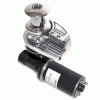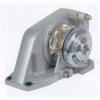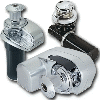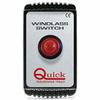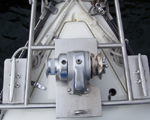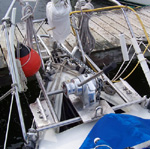About Windlasses
- How they work
- Features to look for
- Orientation (vertical vs. horizontal)
- Gpysy/Rode Compatibility
- Pulling Power
- Configuring your windlass (including photos)
As boats become larger, the size of their anchors increases to a point where they cannot be weighed by hand. Rather than downsize your boat or use inadequate ground tackle, consider installing a windlass. Windlasses reduce the effort required to raise or lower your anchor and rode with electrical power, or by adding mechanical advantage to your muscle power.
How they work
Windlasses are powered by one of three methods: muscle power (manual), electricity or hydraulics. We’ll examine the first two types, as hydraulic windlasses are generally used only on very large vessels.
Windlasses generally mount in the center of the boat’s foredeck, aligned with an anchor roller of some sort. Most boats have an anchor roller/mount that stores the anchor when not in use. Other boats store the anchor in chocks or a locker on deck. All boats need a roller to pass the anchor rode smoothly over the rail of the boat.
Manual Windlasses
Manual windlasses multiply your strength through mechanical advantage. They also ratchet in one direction so the rode does not run backwards. Because they require you to be on deck to raise or lower your anchor, they’re generally limited to small– to medium–sized boats. Their chief advantages are relatively low price, no need for electrical wiring and their relative simplicity, which reduces maintenance and the chance of failure.Manual windlasses come in one and two–speed models, and most are double–action, meaning that the windlass pulls on both forward and backward strokes. Two–speed windlasses are similar to two–speed sheet winches: they have a fast, low–power speed for easy pulling, and a slow, high–power speed for increased power.
Some manual windlasses rotate in a vertical axis like a sheet winch. This limits the amount of power they can develop, based on length of the handle, but allows them to be more compact and very simple in construction.
Electric Windlasses
Using a 1/2– to 2–HP electric motor to help weigh anchor turns anchoring into a push–button operation (mostly). Electric windlasses will raise an anchor at 35’–100’ per minute, and can exert a pull of several thousand pounds on your anchor rode. Many windlasses can lower your anchor by push button as well. Some even drop anchor faster than they retrieve to reduce the time you spend with your finger on the button, either by clutching the shaft so that it free falls or by using a gear change mechanism.Unless they are dual–direction windlasses, most electric models use a clutch–release mechanism to allow the anchor line to pay out. Unfortunately, this requires someone to operate the clutch from the foredeck.
What to look for
Ideally, windlasses should raise and lower anchor line without operator intervention except to push a button. Anchor rodes can be under great tension, and they pose a risk to fingers, feet, hands, etc. We don’t like the idea of transferring a line under tension from a capstan to a chain gypsy–the drum with link–shaped depressions that cradle and pull along the individual chain links–in the middle of weighing anchor or when clearing a jam from a balky system. Furthermore, we believe that windlasses should pass the line below decks to a locker, rather than pile the line on deck so that you have to stow it.
For these reasons, we prefer a self–tailing/self–stowing windlass that does not require the operator to come into contact with the rode. Self–tailing windlasses handle three types of rode: rope only, rope and chain, and chain only.
Note: A self–stowing windlass requires that your anchor locker be set up correctly. Specifically, the anchor rode must have a long "fall" so that it doesn’t stack up under the incoming rode. A poor anchor locker design will render the installation of an otherwise ideal windlass useless. Before installing a windlass, consider the depth of your locker, and where the rode is going to go.
Rope Only
Simple rope capstans let you wrap the rode around a drum and use the electric motor for power. By pressing a button on the deck or windlass case, you haul the rode in by hand the same way you would tail a sailboat’s sheet winch. You’ll end up with a pile of line on deck that must be coiled and stowed, and you need to go forward in order to operate the windlass. While helpful when anchors are stuck in the bottom, or when singlehanding a boat in lots of wind, we don’t find rope–capstan windlasses to be much of an advantage.Rope–only self–tailing windlasses wrap the line around an internal pulley and deposit it below, and are generally restricted to one or two sizes of three–strand anchor line. You are limited to a length of chain that does not exceed the distance from the windlass to the anchor roller, generally a few feet or less, which we think is inadequate for most rodes.
Rope–chain
Rope–chain windlasses use a single gypsy with normal chain pockets on the perimeter and V–shaped grooves in the center to handle rope. This requires that your anchor rope be spliced directly to the last link of chain. This may be a source of concern to some boaters, but tests we’ve conducted have made us comfortable with this approach. Naturally, the splice should be checked regularly for chafe.Pride Marine will perform rope-to-chain splices on NEW rope only. Feel free to call us for such requests.
All–chain
All–chain gypsies are self–tailing, due to the nature of the chain as it engages the pockets in the gypsy, and are self–stowing, since the weight of the chain causes it to fall through the chain pipe into the rode locker. Many cruising boaters favor all–chain rode. It is highly abrasion–resistant, lies on the bottom in most conditions, and is strong. It is also heavy, expensive, and collects mud.
Orientation
Windlasses are categorized as horizontal or vertical. This orientation is from the perspective of the capstan/gypsy's axis, not the perspective of the rode direction. Which style should you choose? Measure the depth of the anchor locker to determine the amount of "fall" available (distance between the top of the anchor locker and the top of the anchor rode when it is completely stored inside). This is the most important measurement to help you decide which style to select.
Vertical Windlasses
More of the low–profile unit is hidden below deck and out of the wettest environment. Vertical windlasses generally require a larger hole for the motor, which hangs below the deck. Suitable for boats with larger chain lockers; they require a longer fall for the chain. The rode makes a full 180° wrap around the gypsy, providing added security, and feeds through a deck pipe to the anchor locker, making a 90° turn.Horizontal Windlasses
Most of the self–contained windlass is located on deck. You only need to drill holes in the deck for the chain pipe, wire and thru–bolts. Installation is easier than with vertical windlasses. Horizontal models are good for boats with small or unusually shaped chain lockers, usually needing a minimum fall of only 12". The anchor rode enters the gypsy and makes a 90° turn as it feeds down into the locker. Very large yacht windlasses and most manual windlasses are also horizontal. Side–to–side alignment of horizontal windlasses is critical since they cannot accept rodes leading from off–center angles.
Gypsy/Rode Compatibility
It is very important to match the windlass not only to the boat type, but the type of rode as well. This applies to both the size and the type of the chain, so a windlass gypsy designed for 5/16" High Test chain will not work on 5/16" BBB, which has shorter, more compact links. Many windlasses have a selection of gypsies, which can be Special Ordered to fit the existing rode on a your boat.
Pulling Power or Load
The pulling power or load capacity required of a windlass is hotly debated. Windlasses are not intended to pull a boat against a 25–knot wind and 2’ chop with the engine in neutral. They are not designed to break out a heavy anchor under 3’ of hard sand. They are designed to weigh an anchor and rode that is not under strain and to provide enough tension to break out a firmly set anchor. But as any text on the subject will tell you, it is the engine’s power that should be used to move the boat upwind and it is the motion of the boat that should break out the anchor–not the windlass.
Strain on the windlass should be limited to the hanging weight of the anchor and rode. In reality, because many boaters don’t make proper use of their boat’s power when raising the anchor, it is often much greater. Therefore, manufacturers tend to recommend windlasses with hefty pulling power so that you have the capacity to weigh anchor even if your engine is out or it is already running at full capacity or your anchor is firmly stuck.
Lewmar recommends that a windlass’s maximum load capacity be four times its usual "working load"–the combined weight of the anchor, rode and hardware. That is, a 33’ boat with a 22lb. Delta anchor, 200’ of 1/2" rope with 15’ of 1/4" chain and a shackle (about 40lb.), with a total ground tackle weight of 62lb., would select a windlass with at least 248lb. of pull (62lb. of ground tackle, times four).
Maxwell recommends capacity equal to three times the weight of the ground tackle for their windlasses. If ground tackle is too heavy or close to the windlass’s maximum pulling power, or if the boat has lots of windage and/or displacement, select the next larger size of windlass.
Wondering how to fit your new windlass on your bow? Sometimes it is difficult to find a spot for a windlass, so below you will find some creative ways of mounting your windlass. We are always looking for more ideas, so do not hesitate to contact us and share photos of your brilliant inventions!




 Proudly Canadian, est. 1999.
Proudly Canadian, est. 1999.


